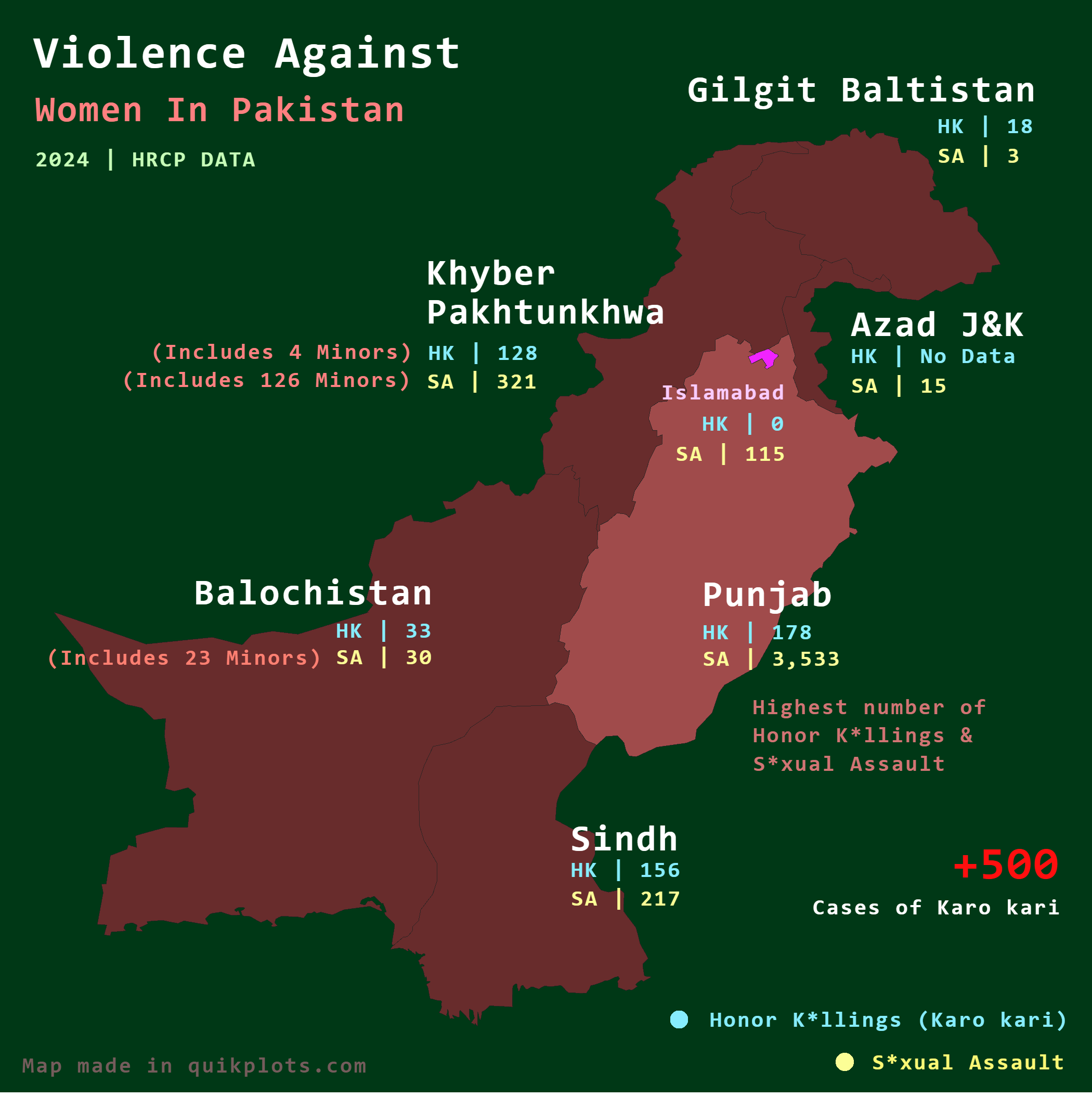Violence Against Women in Pakistan Map


Alex Cartwright
Senior Cartographer & GIS Specialist
Alex Cartwright is a renowned cartographer and geographic information systems specialist with over 15 years of experience in spatial analysis and data...
Geographic Analysis
What This Map Shows
The visualization titled "Violence Against Women in Pakistan" provides a stark representation of the incidents of Karo Kari (honor killings) and sexual assault across various provinces of Pakistan. This data, sourced from the 2024 State of Human Rights report by the Human Rights Commission of Pakistan (HRCP), highlights the alarming prevalence of violence against women, illustrating the geographical disparities in such incidents. Each province displays different rates and types of violence, allowing for a comprehensive understanding of the issue at a regional level.
Deep Dive into Violence Against Women in Pakistan
Violence against women in Pakistan is a pervasive issue, deeply rooted in cultural, social, and economic factors. According to the HRCP report, Karo Kari, often referred to as honor killings, remains a significant concern. This practice involves the murder of women (and sometimes men) by family members, often justified by a perceived need to protect family honor. Interestingly, the motivations behind honor killings can range from issues of love and marriage to accusations of infidelity or even the desire for greater autonomy by women.
In 2024, the report indicated that Karo Kari incidents were most prevalent in Sindh and Punjab provinces, where traditional honor codes are deeply ingrained in societal structures. For instance, in Sindh, cases often arise from disputes over dowries or the refusal to adhere to arranged marriages. In contrast, Punjab, being the most populous province, reported a higher number of cases due to its larger population base. This stark contrast in numbers reflects not only the demographic factors but also the cultural attitudes towards women's rights in these regions.
Sexual assault (SA) is another facet of the violence women face in Pakistan. The HRCP report notes an increase in reported sexual assault cases across all provinces, with a particularly concerning rise in urban areas where women are increasingly entering the workforce. This shift has had mixed consequences; while it has empowered some women, it has also led to backlash from conservative factions, resulting in more frequent assaults. Interestingly, the report highlights that many cases go unreported due to societal stigma and fear of retribution, suggesting that the actual numbers could be significantly higher.
Regional Analysis
When analyzing the map, it’s crucial to note the regional variations in violence against women. In Sindh, for example, the data shows a worrying trend in honor killings, with rural areas reporting higher incidents compared to urban centers. This disparity may be attributed to more conservative social norms in rural communities, where traditional values dominate.
Punjab, while more urbanized, also grapples with significant issues surrounding Karo Kari and sexual assault. In major cities like Lahore, the urban landscape has created opportunities for women, yet it has also led to rising tensions regarding gender norms. The juxtaposition of modernity and tradition in Punjab's diverse urban areas presents a unique challenge; reports indicate that women in these settings often face harassment in public spaces, reflecting a broader societal issue.
Khyber Pakhtunkhwa (KP) and Balochistan, on the other hand, display different dynamics. KP has traditionally been influenced by tribal codes, which can complicate the legal recourse for victims of violence. The report indicates a need for greater legal protections and awareness in these areas. Balochistan, with its vast geographical expanse and limited access to education and health services, also reported a troubling number of cases, often linked to economic deprivation and lack of awareness regarding women’s rights.
Significance and Impact
The implications of violence against women in Pakistan are profound and far-reaching. At its core, this issue not only violates fundamental human rights but also hinders the social and economic development of the country. The trend of increasing violence against women reflects broader societal attitudes towards gender equality, which remain entrenched in many parts of the country.
Interestingly, as the conversation around women's rights gains traction globally, there is hope for change in Pakistan. Activism and advocacy efforts are slowly shifting public perceptions, and initiatives to educate both men and women about gender equality are emerging. However, real change will require not only legal reforms but also a fundamental shift in cultural attitudes towards women. The HRCP report emphasizes the importance of creating safe spaces for women to report violence and seek justice, a crucial step towards addressing this pervasive issue. As we look ahead, the need for collective action—both locally and internationally—remains paramount in the fight against violence towards women in Pakistan.
Visualization Details
- Published
- October 1, 2025
- Views
- 50
Comments
Loading comments...